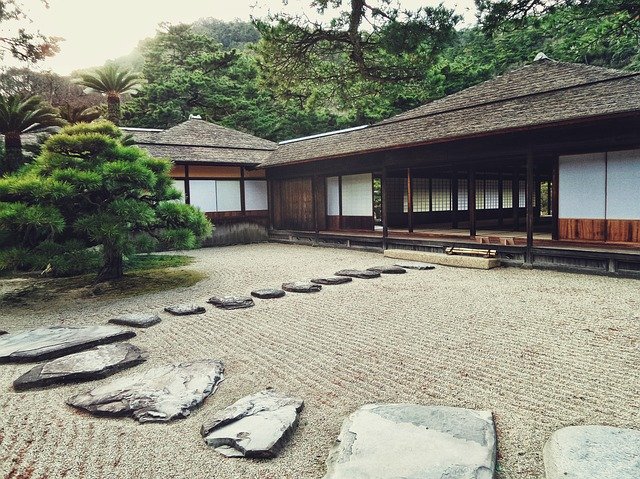Japanese zen gardens are all about tranquility, balance, and harmony. They’re also typically quite minimalistic and don’t feature as much in the way of grass and flowers as a more English-style country garden might. To decorate your garden with Japanese zen most often means turning to sculpted items of stone like statues, lanterns, bowls for hardy but delicate-looking plants, and more.

Below you’ll find some of the most common and popular features of a Japanese zen garden.
1. Dry Landscape
Perhaps the most striking thing about the design of a typical zen garden is the absence of green grass, or even earthy soil. The main landscape feature of a zen garden is typically formed using gravel, sand, wood or rock elements. Gravel is the most common choice because it is more secure and stable, and remains undisturbed even by strong winds.
This gravel or rock surface is often raked to shape it, give it lines and create more of a sense of order and evenness along the surface. The raked surface is also there to create a ripple-like aesthetic, which is reminiscent of water. Traditionally, the zen priests who managed these gardens would rake the stones as a way to hone their skills of concentration.
2. An Enclosing Wall
If one is creating a zen garden in the most traditional sense, then it must certainly be walled off or otherwise contained. Miniature versions created for people to have indoors are usually contained with some kind of small open-top box. Outdoor gardens of any size are closed off either with a fence or a stone wall.
3. Stone Lanterns
Lanterns are a very common man-made feature in a traditional Japanese zen garden. The first common type is the Miyoshi stone lantern, first developed during the 16th century in Japan and used mostly for lighting paths through gardens, especially to tearooms. They are a tall, slender granite construction with a shallow pyramidal top and a 9-square grate to allow light through.
Another popular style is the Kanjuji lantern. When made in the traditional fashion, a Kanjuji stone lantern is carved from silver grey granite and made in 7 pieces. One distinguishing feature is the curved lid of granite that sits atop a rectangular box placed on another granite plinth with an opposite-facing curve to the stop. Underneath is a foundation of two slabs of granite with a hollow supporting cube.
Curved and arched stone within the various stone structures in the zen garden are representative of fire, which are placed in conjunction with other rock representations of elements (more below).
4. Stone Balls
Balls in differing sizes and made from different stone materials are another popular addition to a zen garden. They are delightfully simple and elegant in their look, but inspire awe as to how they are made, the more you look at them. Two common materials used in the creation of these decorative stone balls are granite and lavastone.
Granite offers a more refined finish, especially when it’s polished. Lavastone is somewhat rougher, but has a ruggedness and wildness that brings more of a natural feel to the zen space. If your zen garden has more greenery, lavastone is a nice addition because it ties in better with the greenery, imitating a natural scene.
5. Upright and Flat Stones
Besides crafted features like lanterns, zen gardens also feature more natural stones placed upright or laid down flat. When stones are upright in the zen garden, they are there to represent trees, mountains and other standing features of nature. Flat stones are usually used to represent water.
Hey welcome to my blog . I am a modern women who love to share any tips on lifestyle, health, travel. Hope you join me in this journey!

Speak Your Mind